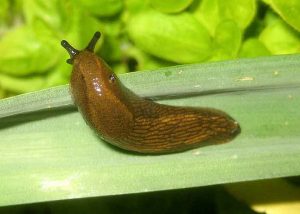
We were convinced of this on our own experience, traveling around the city by public transport.
A full minibus gardeners are talking on their favorite topics. And then one pensioner sighs that she has all the gladioli in the holes.
What was my answer about slugs. If you are defeated by these pests, then the fight against slugs in the garden with folk remedies will be productive after the following recommendations.
The content of the article:
- 1 Slugs and snails. Control and struggle with gentle methods
- 2 Biological controls
- 3 How to get rid of slugs in the garden
- 4 Preparations, chemical and biological agents
- 5 Mechanical methods, improvised and folk remedies
- 6 Traditional methods of dealing with slugs
- 7 Naked slugs and measures to combat them
- 8 Folk remedies against slugs and snails
- 9 Fighting slugs in the garden with folk remedies, methods without chemistry
Slugs and snails. Control and struggle with gentle methods
Slugs and snails are great garden pests! In hot and dry weather, they hide in secluded parts of the garden, where it is always dark, cool and humid. And at night, when dew falls, or on rainy days, slugs and snails crawl out to hunt in the garden, sometimes completely destroying the leaves of young garden plants and the ripened crop
Slugs and snails prefer fruit and vegetable crops, in which they willingly devour not only leaves, but also stems, flowers and fruits. Do not disdain snails and slugs by many ornamental plants.
All this, not to mention the appearance of the plant spoiled by snails. Undoubtedly, snails and slugs are malicious garden pests. However, the ecosystem of the garden is very extensive and diverse, and each representative of the fauna plays a role in it.
This role is not always purely negative or positive, and the animal itself can be classified as pests or helpers without a shadow of doubt. So, slugs and snails perform an important sanitary function in the garden, processing dead or damaged plant remains.
Therefore, an organic approach to gardening involves gentle measures to combat them, primarily aimed at strengthening plants and restricting access of slugs and snails to vulnerable plants.
And the chemical destruction of snails and slugs, even with the help of the so-called “Soft” pesticides - the most extreme, forced control measure, which is applied pointwise in short periods of time.
Harm Prevention
The very first preventive measure of protection against slugs and snails is competent gardening:
- technologies for improving soil fertility and structure,
- proper selection of plants
- timeliness of all garden work,
- maintaining garden hygiene
- attracting birds and other useful fauna for natural pest control (in this case, lizards, frogs, toads, fireflies and some other bugs, as well as hedgehogs),
- the right combination of plants
- vegetable rotation and much more.
All these measures contribute to the strengthening of plants, because strong plants can much better resist attacks of garden pests and diseases.
Means of mechanical control
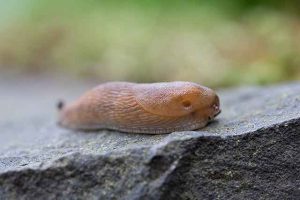
Such gutters are filled with water, which serves as a mechanical barrier to snails and slugs.
Any dry porous materials, as well as fine gravel, crushed shells and eggshells are unpleasant for slugs and snails, therefore, they are well suited as a filler between rows. It should be borne in mind that in rainy weather their effectiveness is significantly reduced.
Also on sale are wide plastic rims with a curved edge, which are fixed in the ground around the plants and keep snails and slugs away from the plant.
Plant vegetables on elevated ridges or containers, tie up legumes, tomatoes and pumpkin to the supports in time, use transparent plastic caps (for example, the lower halves of large plastic bottles of water) and film shelters for young vulnerable plants - all this makes the desired plants for snails and slugs are physically less accessible.
Live slugs and snails should not be placed in a cold compost, as under favorable conditions adults will lay their eggs. Special traps for slugs and snails are a bowl covered with a roof umbrella.
The trap is installed so that the entrances are at ground level. The bowl is filled with beer, fruit juice or other bait (a delicious smell attracts snails and slugs), the roof prevents rain and debris from getting inside.
Distracting maneuvers include old leaves and tops scattered among plantings of plants that are beloved by snails and slugs (lettuce, tomatoes, cucumbers, comfrey, etc.).
I personally successfully use this method in a greenhouse, where it helps to keep in check not only snails and slugs, but also wood lice: carried away by eating these wastes, they no longer crawl to growing vegetables. From time to time, leaves with garden pests that eat them can be collected by replacing them with new ones.
Electrical controls
In the garden centers there are self-adhesive tapes made of copper, rims or covering material with a copper coating (Shocka trademark).
Contact with copper gives the mollusks a slight electric shock, so they will not want to cross the copper barrier. Rims with a small battery have recently appeared on sale that give snails and slugs a small electric shock when crossing.
Biological controls
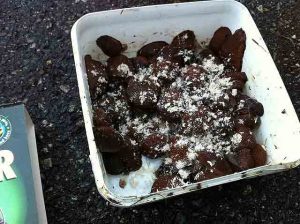
The use of the product is possible from spring to autumn (soil temperature should not be lower than +5 C), it is most effective in wet weather.
The advantages of this biological "killer" of slugs and snails in the duration of action, effectiveness, absolute safety for people and the environment, as well as ease of use. Microorganisms should be diluted with water, and then pour the necessary plantings from the watering can.
Within a week, slugs and snails die, one watering is enough for a month and a half, according to the manufacturer. The inconvenience lies in the short shelf life of the product (3-4 weeks from the date of release, as microorganisms are "preserved" in a living state), and also the need to constantly keep it in the cold.
Phyto-control
The plants that slugs and snails do not like and try to avoid include primarily garlic, as well as many (but not all!) Aromatic plants (lavender, sage, santolina, thyme, rosemary, laurel, etc.), which they never touch.
Garlic is used by manufacturers of special phyto-infusions that repel slugs and snails. Infusions of garlic, bitter pepper and mustard are well-known folk remedies for combating slugs and snails.
Chemical controls
There are metaldehyde granules on sale (sold in Russia under the trademarks Groza and Meta) - an effective tool that attracts and kills slugs and snails. The package says that the product is poisonous to pets and people if it gets into their digestive system.
Manufacturers claim that when used correctly, the product is completely harmless to people, pets and the environment, however, warnings are often found in the horticultural press. Metaldehyde should be stored and used with great care.
Wash vegetables and herbs especially thoroughly; if you used metaldehyde in the garden, make sure that the granules do not remain hidden in the salad greens. I scatter blue granules exclusively around the hosta and only in the early spring, when young leaves appear from under the ground and are especially vulnerable to slugs and snails.
Caffeine against slugs and snails?
Caffeine in the form of an aqueous solution introduced into the soil or on the leaves of plants repels and kills slugs and snails, presumably destroying their nervous system. This conclusion was made by Hawaiian scientists from the US Department of Agriculture as a result of a series of experiments, as reported by Nature.
How to get rid of slugs in the garden
Slug, another name for the slug, is the real enemy of homeowners. The question of how to get rid of slugs is a sore point for them. Why is the pest so dangerous?
Description, features, life cycle
Slug is akin to a snail, only without a shell. This is one of the most common pests in the homeland. The gastropod of the mollusk moves by contraction of muscles. You can determine its presence by eating leaves, holes in tubers, heads of cabbage and fruits.
Moving along the surfaces, he leaves behind a shiny, dried pearly path, as his body is abundantly covered with mucus. On the head there are tentacles in the form of horns, eyes are also located here. The appetite of the parasite is excellent. A sickle-shaped mouth, as well as a tongue with many tiny teeth called a grater, it is able to scrape food from various surfaces.
Ruthlessly cracking down on almost all garden crops, it inflicts irreparable harm to cabbage leaves, lettuce, devours cucumbers, tomatoes, all berries, many types of ornamental plants, and with great pleasure destroys stocks of fruits and vegetables harvested for the winter.
Only knowing how to get rid of slugs and prevent their spread, you can protect the crop from the pest. Its rapid multiplication contributes to increased humidity and relatively low air temperature.
Dry years significantly reduce the activity of slugs: pests produce less offspring, eat less, and therefore do less harm. The slug waits for an unfavorable period, turning into a cocoon. But during rains, he feasts in the gardens and, which is especially dangerous, at the same time carries fungal and viral diseases to plants.
Preventative measures
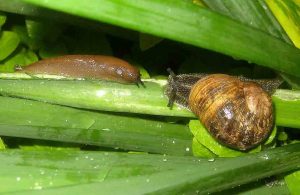
It is more difficult to get rid of slugs on a site than to prevent their spread. What to do?
- In early spring, it is necessary to cultivate the soil with special care and diligence. Simple actions will significantly reduce the number of overwintered eggs.
- In the summer, repeatedly watering the garden, it is often necessary to deeply loosen the ground, throwing out bumps and roots. It is in them that these parasites often hide.
- Planting should be carried out, observing the recommended intervals. In shady thickened places for the pest, the most favorable conditions of existence are created. For the same reason, the aisles and the entire territory should be kept especially clean, as well as drain the wet areas.
Preparations, chemical and biological agents
Luckily for amateur gardeners, there are many ways to deal with slugs. Special preparations for slugs (Meta, Thunderstorm, Sludge Eater, Bros) containing metaldehyde have a detrimental effect on them.
The poison is effective even after two weeks of rain. But in wet weather it is better to abandon its use as an ineffective means.
- On the contrary, only in a humid environment does a biological agent for slugs “work” containing microscopic nematodes Phasmarhabditis hermaphrodit (pictured right). It operates at positive temperatures (above + 5 ° C), but so far it is more common in Europe.
- Visually looking like a powder, this remedy for slugs does not harm the environment and humans. The disadvantage is the short shelf life of the drug - no more than 20 days, and certain conditions - only in the refrigerator. Safe modern remedies help get rid of slugs.
- These include, for example, biological preparations containing iron phosphate. They cause dehydration of the body of the slug, after which the pest dies underground. The substance itself decomposes over time into iron and phosphate, which are organically present in the soil.
- Tilling the soil under cultivated crops with superphosphate or crushed mixed with sand, copper sulfate helps to get rid of slugs in case of a large accumulation of pests.
Plants treated with copper-containing preparations (Bordeaux liquid, copper hydroxide, cuproxate, copper chloroxide, cupritox, abiga-peak, cupricol, cupravit, cuprox, river) are also not attracted to slugs.
Copper-soaked strips and covering material protect the plants from the greedy mollusk. But such remedies for slugs are still rarely found on the market. There are snail and slug traps on sale with a special bait in the kit.
Mechanical methods, improvised and folk remedies
You can get rid of slugs in other available ways. Folk remedies for slugs have been tested for years and are also effective. Mechanical collection is not excluded. For this purpose, in the territory where various crops ripen, it is necessary to lay out boards or large leaves, which will serve as a shelter for the parasites during the day.
In the evening they will be easy to collect and destroy. The method will be effective if it is repeated several times in a row. You can sketch the bait from the crusts of melon, watermelon, pumpkin. Slugs are nocturnal. At this time of the day they creep out to fishing, so at dawn they can also be neutralized.
Do not forget that high temperatures damage slugs. To combat them, you can apply plant mulching using a film, under which there is always high humidity. In the dark, pest parasites gather there. During the day, while inside, they can not withstand temperatures under the scorching sun.
A disastrous measure is watering with hot water heated to +40 ° C. This remedy is only applicable to protect cabbage. Along the perimeter of the beds, you can dig grooves into which ash is mixed with the same amount of tobacco dust. The procedure is repeated after two weeks.
The creation of artificial barriers has a flawless effect. Slugs do not like to crawl along coarse sand, crushed shells, nuts and eggshells, sawdust, lime, pine, and also spruce needles, because all these objects cut the abdomen. Salt, soot just corrodes them. They certainly won’t go through such an obstacle.
- A cut off plastic bottle or a special bezel with a curved edge will become an insurmountable obstacle to the crawling pest. Install them near the desired plant (caputa, hosts) or around the entire planting, they will help get rid of a large number of slugs.
- Slugs do not like coffee grounds, use it in the fight against pest.
- A good effect is given by a solution prepared from 1 liter of water and 2 tablespoons of ammonia. Spraying is carried out in the evening, when pests leave the shelter.
- Spraying with tincture of water and pods of hot pepper is considered a proven folk method.
It should be noted the great love of monsters for beer. Two simple, but rather original ways of its application deserve attention:
- Large fresh leaves of burdock should be placed in a bowl with beer and soaked, and evenly spread out late in the garden. By morning, all the leaves will cling to the slugs. It remains only to collect them and render them harmless.
- A cropped plastic bottle with a small amount of hops drink is dug into the ground. Slugs fall directly into it or are nearby, 2-3 such treats will allow you to forget about pests for the whole season.
How not to harm
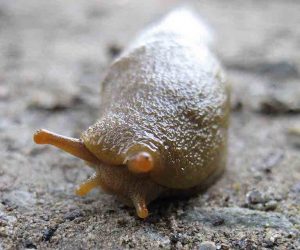
Their complete destruction with the help of chemicals is an extreme and undesirable measure. It is much more useful to use folk remedies or the plants themselves.
Do not forget that parsley, dill, garlic, as well as lavender, sage, peonies scare away some pests. An equally effective measure can be a small pond that attracts snails and slugs.
Crows, jackdaws and poultry also eat the pest. To save garden plants, all measures are good, but it is best to try to avoid the use of chemicals and try to get rid of slugs with folk remedies or biological.
Traditional methods of dealing with slugs
Agree, slugs are a rather unpleasant attack. First, they spoil, almost every strawberry. Then they systematically move to tomatoes, peppers and eggplant, gnawing holes in the fruits, and sometimes even settling in them.
The same slugs damage cucumbers and cabbage, eat out grooves in the roots of carrots and beets. Is there really no salvation from this? It will be necessary to deal with slugs in a complex, and prevention is the best remedy.
In principle, the nature of the enemies of gastropods is quite enough, but they are not so often found in our gardens. Hedgehogs, frogs and toads eat them with great pleasure. True, in the conditions of our plots quite often these natural enemies simply have nowhere to stumble on, and therefore they bypass the gardens.
Slugs do not pass by and thickets of grass, where it is good to hide from the destructive sunlight. Therefore, as a preventive measure, timely removal of weeds and mowing of grass along the edges of the plot are recommended. Make their life rough!
Slugs and snails are extremely dislike the rough surface. It is necessary to fill insurmountable strips of coarse-grained sand, crushed egg or nut shells around those plants where gastropods were seen, creating peculiar thorny barriers.
But here you need to regularly monitor so that no gaps form in the wall through which the insidious and gluttonous enemy can penetrate. A great way to scare away slugs are considered crushed river shells with sharp edges that sprinkle with ribbons between the beds.
- If possible, then mulching your plantings with pine needles will give truly phenomenal results (especially this, of course, applies to spruce needles). Slugs immediately begin to avoid encroaching on plants, protected by a thick coniferous carpet.
- Under the plants of tomato, pepper or eggplant, to which slugs are big lovers, you can lay out dried nettle plants. Slugs are afraid of them, and if there are a lot of nettles, they will prefer to bypass this place. Treat yourself with a beer!
- Slugs and snails cannot resist beer that is even exhausted (they are true connoisseurs of this drink and, according to German gardeners, prefer its dark varieties). You can take advantage of this addiction by breaking glasses into the ground and filling them half with beer.
- Particularly immoderate simply drown in beer, more restrained "fall off" next to the "life-giving source." The method is original and, as it was said, very effective - two or three such “feasts” and you can forget about slugs before the end of the season.
- Instead of glasses, other containers will do. For example, in the most lowered areas you can install a whole basin, or you can dispense with glasses made of plastic bottles. Or take the whole plastic bottles, pour some beer and lay flat on the ground, squeezing one side a little so that the bottles become flat and do not roll.
It is worth noting that mussels especially avoid substrates such as ash, superphosphate or lime. Superphosphate by today's standards is, of course, an expensive thing, so it’s easier to stay on ash or lime.
Perhaps the simplest means is to sprinkle aisle with lime after rain or watering, when the slugs begin to move actively. Getting on the stripes of lime, they burn their abdomen and die. You can take not pure lime, but mixed with ash or tobacco dust (1: 1).
In the absence of rain, the soil is thus treated late in the evening or at night, when the slugs are on the soil or on the plants. Soil treatment is periodically repeated (after 7-15 days), which leads to the gradual death of mollusks.
The main thing during this procedure is to successfully select places for dispersion of drugs in order to block the main lines of their movement from slugs. It should be borne in mind that filing is effective when slugs "graze" - that is, after sunset.
To protect garden strawberries, it is recommended to sprinkle the ground with spruce or pine needles or lay a layer of spruce or pine legs on the soil. The needles will crumble to the surface by themselves and serve as protection from slugs.
In addition, they will protect the soil from drying out and then serve as fertilizer. And the skeletons of spruce and pine paws will serve as support for the berries, protecting them from touching the ground. For dessert - grapefruit.
- American gardeners recommend a very original way of trapping slugs using grapefruits. It is enough to take half of the grapefruit peel, cut a small hole in it and set this domed trap.
- Attracted by the smell, gastropods will gather under the skin during the night, and in the morning it remains only to collect them and eliminate them by placing them in boiling water or in a concentrated solution of table salt. However, in our conditions it is easier to catch slugs in more accessible (and most importantly - available on any garden plot) traps.
- As the latter, ordinary trimmed boards, pieces of slate or roofing material, wet rags and burlap, linoleum, watermelon peels, cabbage leaves, etc., are quite suitable - in such shelters, slugs like to crawl for a day. And you just need to decompose all these objects in the evening in suitable places, and in the morning go and collect the mollusks hidden in the traps.
Among the chemicals for controlling slugs, thunderstorm, metaldehyde, is most known. The tool is very effective, but quite expensive. It is a multi-colored granules, usually blue.
But voracious slugs, this "food" is destroyed with pleasure. Do not pour granules in piles - it is more efficient to lay them out at a distance of 10-15 cm from each other. This is quite enough for gastropods, and you will save a lot.
Naked slugs and measures to combat them
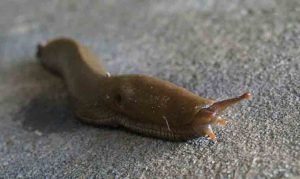
Naked slugs are very widespread. They live in soil, under turf and stones, in deciduous litter and in other similar places. Naked slugs prefer to settle in places with moist soil.
Harm both adults and young individuals. Naked slugs especially severely damage clover, cabbage, rutabaga, beets, carrots, potatoes, and especially winter seedlings in autumn, eat oblong holes in the leaves or indentations in potato tubers, rutabaga, carrots, beets, and strawberries; at seedlings of winter, leaves are eaten, seeds sown are eaten away.
Naked slugs feed at night, and during the day only in cloudy weather. With increased rainfall in summer and autumn, the following year is usually characterized by massive reproduction of bare slugs.With dry spring and high summer temperatures, the number of slugs is sharply reduced.
The emergence of juveniles from eggs in naked slugs occurs two to three weeks after egg laying. Sixty days after leaving the eggs, the slugs already become sexually mature. Naked slugs winter mainly in the egg phase.
An ordinary field naked slug has a smooth body, yellowish-white or grayish-pink. Body length 30-60 mm. It lives in the forest and often in open places. Serious vegetable pest.
Brown arion slug has a body with dense tightly stretched skin, each side is covered with 24 rows of shallow wrinkles. The body is yellow-orange or reddish in color, brownish at the back, yellowish-white to the sole, two dark side stripes with fuzzy contours.
Body length 50-70 mm. This species is especially widespread: in the north these bare slugs live up to the shores of the northern seas, and in the south to Kiev and Kharkov. But the bare slug brown arion is less harmful than previous slugs.
Naked slug control measures
The fight against slugs should begin with a thorough cultivation of the soil, drainage of roadside ditches, ravines, puddles and other damp areas, cleaning and processing of turf and stones. Fighting slugs is not a simple matter, for this it is necessary to destroy weeds, especially in steam fields.
Remove leaves, cabbage, rutabaga and other plant crops from the fields. In the fight against slugs, it is effective to treat the site with ash with the addition of 25-30% lime at a dosage of 200-250 kg / ha, superphosphate - 300-600 kg / ha, spraying the crops with a 10% aqueous solution with sodium chloride. Spraying is performed at night, when the slug comes out to eat.
Folk remedies against slugs and snails
Slugs and snails are invisible night hunters to our cabbage. During the day they hide in the secluded, dark and humid corners of the plot, and in the evening creep out onto cabbage beds and eat, eat, eat ... In the morning, all the leaves of cabbage are in uneven holes, and no one is visible - slugs hid.
What to do in this case?
The first way. Good old folk method of dealing with slugs - device bait. To do this, in the evening (at 20-21 hours), when the slugs begin to get out of the shelters, next to the cabbage bed, trays of kvass, juice, beer or diluted jam with yeast are dripped. You can moisten old rags or burdock leaves in the “drink” and spread them over the furrows. Throughout the night, the slugs will crawl into the smell, and in the morning you can take pests with your bare hands.
The second way. Sprinkle mustard powder between the cabbage. Slugs can't stand him.
The third way. Prepare a solution of 40 ml. ammonia in 5-6 liters of water and pour from a watering can directly on the leaves and heads of cabbage. After a few minutes, return to the garden and repeat the procedure: at this point, all the slugs will come out of the ground and from the cabbage, and the ammonia solution "will hit right on the enemy."
The fourth way. Tear and lay out leaves and stalks of nettles on the bed. For nettles, slugs will not climb to your cabbage. True, it dries quickly, so nettle protection needs to be updated every day, but this is more of a plus than a minus, because you are simultaneously fighting slugs and mulching plantings with wonderful organic material.
The fifth way. The crushed egg shells scattered around the cabbage will become an insurmountable obstacle for mollusks. But where to get so many shells? Save up all winter! What else to save in winter, then to use in the country.
The sixth way. Sprinkle the soil on the cabbage bed with an infusion of hot pepper.To prepare it, you need to grind 100 grams of pepper, pour a liter of water and insist for two days. Then bring to a boil and insist another day.
Then squeeze the pepper and strain the infusion. Half a glass of pepper infusion is diluted in a bucket of water and, as usual, a spoonful of liquid soap is added before spraying. The remaining concentrate can be stored in tightly closed containers in a dark and cool place.
The seventh method. The beds, where slugs are rampant, are shed with a solution of ordinary pharmacy greens (1 bottle per bucket of water). Slugs go away.
Fighting slugs in the garden with folk remedies, methods without chemistry
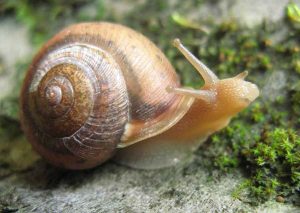
The most harmful damage to the slug is caused not by ripening strawberries or cabbage pouring in cabbage, but by the first seedlings at the level of the cotyledons. An inexperienced summer resident may not suspect why his crops of cucumber or peas so poorly ascended, accusing the seller of seeds or improper weather.
But in fact, sometimes the true cause can be snails and slugs that ate young seedlings of vegetables.
The most vulnerable crops for slugs: salad, cabbage, cucumbers, turnips, peas.
Less susceptible: beets, pumpkin, zucchini, corn, tomatoes.
Slugs and snails live where weeds are nearby or have recently been. A very big mistake is the planting of crops that are tasty for them immediately after digging the soil overgrown with weeds - all the slugs usually remain in the ground and just wait for “lunch” for any seedlings that appear nearby.
The first tender seedlings of planted vegetables are eaten first, then they can switch to radishes, and then, during the summer, to strawberries, potatoes, cabbage ...
Known methods for controlling slugs in a garden without chemistry:
- Digging and trampling aisles. Some slugs die under the weight of a person.
- Spilling soil with hot water (approximately +50 degrees). Snails do not withstand overheating, water takes them out in the soil at a depth of 10-20 cm, while the cabbage for cabbage for a short time does not harm this temperature. This method is especially effective in hot weather.
- Dusting seedlings with ash, hot pepper, lime.
The best folk remedy for slug control
There is a simple method for slugs that does not require complex actions. But like any reliable means of struggle, it requires a gradual and accurate implementation. You will need only a regular plastic film. You can take any bags, the remains of transparent polyethylene from last year's greenhouse, and even a black film.
Therefore, proceed as follows: already at the stage of planting, put pieces of film at night in the row-spacings, lightly dusting them with earth or pressing them with a stone so as not to blow off the wind. It is not necessary to straighten the packages evenly, they can also be crumpled.
In the morning, remove and rinse the films in a basin with water, washing off all the slugs and other snails gathered under it. Repeating this every day, you will certainly remove them from your garden in a few weeks.
Some of them will die before your arrival - they will not tolerate high temperature under a heated film. It is even better to use this method even before planting, having previously reduced the number of pests in the soil.
I live in the private sector, in the summer in the garden slugs constantly accumulate near the main drip irrigation pipe, so many are collected there that it is nasty to weed the grass.
She also set traps with beer, it’s not bad at all, but they are better caught on Coca-Cola. And I also advise anyone who has the same situation to sprinkle eggshells around each plant, this will protect the fertilizer from pests, and it will also fertilize. I have been collecting and drying since winter.
Unfortunately, I am a lazy man in fact, therefore of all the listed methods that I’m tired of reading about, I use only salt. It works flawlessly, and even the grass does not grow ... But after that, it’s painful to look at the slugs: they simply “creep out,” or rather, spread out. Mustard mustard to try.
Something I don’t really like, that the article gives a hint that folk methods are so proven over the years and very, very effective. For me, all of these "folk" recipes, if effective, are then a maximum of a couple of days. It’s best to buy what kind of drug in the store (in magicians like “Agricultural chemistry” that once were), sprinkle a couple of times - and there will be no slugs. And then soon stage IV cancer will be treated with daisies :)
Indoors, in cellars, in wells, I know a way to remove slugs. It’s just sprinkled with salt and sprinkled with salt wherever you can. So in the past and the year before last, I got rid of them all summer. It is necessary to constantly sprinkle with salt, but I didn’t leave my house because of an illness, so they appeared again And I don’t know how in the garden?
Feel free to pour in the rooms where salt can be, sprinkle with salt what you can. In the well-walls, in the basement and the walls and the floor, they are from the SALT. But in the garden?
To combat slugs, we sprinkle superphosphate on the site of accumulation of slugs in our area. Although this is not the cheapest way to get rid of slugs. But very, very effective.